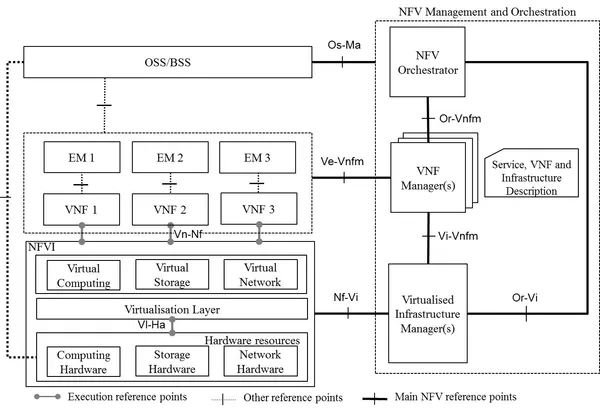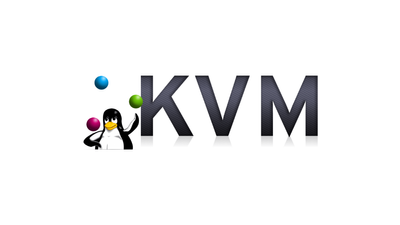Introduction
The European Telecommunications Standards Institute (ETSI) is an independent, not-for-profit, standardization organization in the telecommunications industry. Over the years ETSI have developed a number of standards/frameworks around NFV, that has lead to NFV ETSI MANO (Management and Orchestration).
We will first look at the inital NFV standards from ETSI, which include the High-Level NFV Framework and also the Reference Architectural Framework, before finally answering the question - What is ETSI MANO?
ETSI NFV ISG
In November 2012, the NFV Industry Specification Group (ISG) was formed to develop the required standards for NFV as well as sharing their experiences of NFV implementation and testing.[1]
There are two leading ETSI NFV Group Specifications (GS) - NFV Architectural Framework and NFV Management and Orchestration.
NFV Architectural Framework
The ETSI NFV ISG Architectural Framework (ETSI GS NFV 002) standardizes NFV by defining the various elements required in virtualizing networking functions. This framework contains two main sections - the High-Level NFV Framework and the Reference Architectural Framework.
High-Level NFV Framework - This framework describes, at a high level, the implementation of Network Functions on physical and virtual infrastructure. This is based upon three NFV working domains:
- VNF (Virtual Network Function) - A software implementation of a network function which is capable of running on top of the NFVI.
- NFVI (NFV Infrastructure) - A set of resources (physical or virtual) used to host and connect VNFs, such as compute, storage, or networking.
- NFV Management and Orchestration (MANO) - Covers the management and orchestration necessary for provisioning VNFs, along with their life cycle management.

Figure 1 - High-level NFV Framework.[2]
NFV Reference Architectural Framework - This framework extends the previously mentioned High-Level NFV Framework. It focuses further on functional blocks, their interactions, and the changes that may occur within the operator's network as a result of the virtualization of networking functions.
Along with the new functional blocks within the Management and Orchestration domain (explained further within the next section), we can also see the addition of the OSS/BSS and also the EMS*, and how they link to the other NFV working domains.

Figure 2 - ETSI NFV Architecture.[3]
-
The definition of terms for OSS/BSS and EMS are shown below:
-
OSS (Operational Support Systems) - In telecommunications, software (occasionally hardware) applications that support back-office activities which operate, provision, and maintain the communication network.
-
BSS (Business Support Systems) - In telecommunications, software applications that support customer-facing activities: billing, order management, customer relationship management, and call centre automation.[4]
-
EMS (Element Management System) - Performs management (configuration, alarm administration, etc) to a single or group of similar nodes.
NFV Management and Orchestration (MANO)
The NFV Management and Orchestration (also known as MANO) Group Specification defines a framework for how VNFs are provisioned, their configuration, and also the deployment of the infrastructure upon it will run.
Components
MANO is built around Entities, Descriptor Files, Repositories, and Functional Blocks.
Entities
Entities are the fundamental elements that form an ETSI MANO based environment.
- Virtual Network Function (VNF) - Virtualized task formerly carried out by proprietary, dedicated hardware.
- Physical Network Function (PNF) - Purpose built hardware that provides a specific networking function, i.e. firewall.
- Virtual Deployment Unit (VDU) - Represents the VM that will host your virtual function. A VNF can consist of multiple VDUs.
- Virtual link (VL) - Provides connectivity between VNFs.
- Connection Point (CP) - The corresponding connection points for the virtual links.
- Network Service (NS) - A set of VNFs, VNF Forwarding Graphs, Virtual Links (VL), and Connection Points (CP) that together form a 'network service'.
- VNF Forwarding Graph (VNFFG) - One or more forwarding paths across VNFs via either a single or set of Virtual Links (VL)/Connection Points (CP).
Descriptor Files
For each element there is a descriptor file, i.e. a NSD, VNFD, VNFFGD, VLD, CPD etc. Each descriptor file describes the configuration parameters for the given Entity.
Repositories
Repositories hold information in ETSI MANO. There are four main repository types:
- NS Catalog - A repository of all usable Network Service Descriptors (NSD).
- VNF Catalog - A repository of all usable VNF Descriptors (VNFD).
- NFV Instances - Holds information of all VNF instances and Network Service instances.
- NFVI Resources - A repository of utilized NFVI resources for running Entities.
Functional Blocks
Finally, in order to orchestrate all of the above, NFV MANO is built upon 3 functional blocks:
- NFV Orchestrator (NFVO) - Onboards new Network Service (NS), VNFFGs, and VNF packages. Authorizes and validates NFVI resource requests. Along with manages the NS lifecycle, and performs validation/authorization of NFVI requests.
- VNF Manager (VNFM) - Is responsible for the life cycle of VNFs, such as the creation and termination, along with the FCAPS (Fault, Configuration, Accounting, Performance and Security Management).
- Virtualized Infrastructure Manager (VIM) - Controls and manages the NFVI (Network Function Virtualization Infrastructure) such as the virtual/physical compute, storage, and networking resources. Along with collecting events and performance metrics.

Figure 3 - The ETSI MANO model.
NOTE: The specifications of each of the reference points between the three main MANO components can be located within the ETSI GS NFV-IFA 006-008 documents. This standardization of reference points allows interoperability when building multi-vendor ETSI MANO platforms.
References
"ETSI - NFV." http://www.etsi.org/technologies-clusters/technologies/nfv. Accessed 22 Aug. 2017. ↩︎
"GS NFV 002 - V1.1.1 - Network Functions Virtualisation (NFV ... - ETSI." http://www.etsi.org/deliver/etsi_gs/nfv/001_099/002/01.01.01_60/gs_nfv002v010101p.pdf. Accessed 21 Aug. 2017. ↩︎
"GS NFV 002 - V1.1.1 - Network Functions Virtualisation (NFV ... - ETSI." http://www.etsi.org/deliver/etsi_gs/nfv/001_099/002/01.01.01_60/gs_nfv002v010101p.pdf. Accessed 21 Aug. 2017. ↩︎
"The Definition of OSS and BSS | OSS Line." 5 Dec. 2010, http://www.ossline.com/2010/12/definition-oss-bss.html. Accessed 22 Aug. 2017. ↩︎










